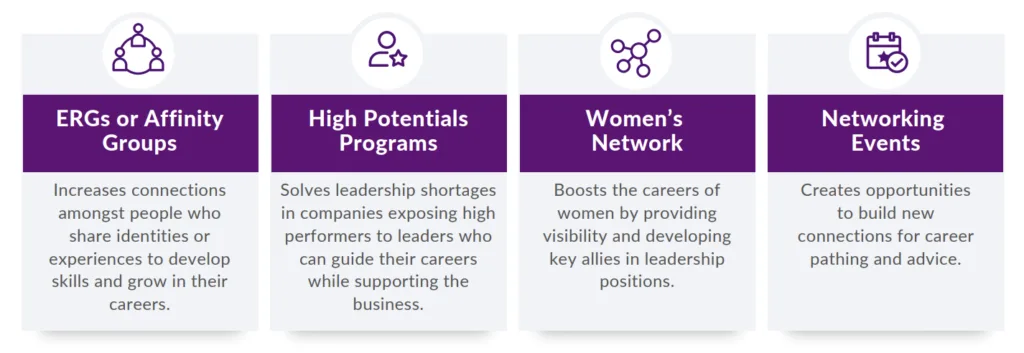During the US western migration in the 1800s, settlers would often do what was called “circling the wagon”: lining up the wagons in a circle to protect them. This gave them a 360-degree view of their surroundings and allowed them to protect precious resources and people inside the wagon circle. An effective DEI strategy works just like that. The tight labor market means puts your company at risk of losing talented BIPOC and female professionals to other organizations with more to offer.
It doesn’t have to be that way. The pandemic caused widespread epiphanies among professionals, leading many to decide that work must be about more than just money. “Just enough” is not going to be enough, but that also begs the question: When it comes to DEI strategies, what’s going to work to retain and attract talent?
This post will walk you through 3 strategies you should consider as you examine your DEI approach this year. Each strategy is backed with examples and data to help you better understand why it’s a necessary approach.
Take It With you:
3 Essential DEI Strategies eBook
Why Do I Need a DEI Strategy?
Sometimes, it can feel like diversity, equity, inclusion and belonging (DEIB) just appeared out of nowhere in the past two years. While these terms have existed for a long time, the pandemic and the racial tensions that followed were invariably a historical flashpoint for DEIB, both in society at large and in the workplace.
Data tells that story rather clearly. Google Trends data shows that search volumes for “DEIB” increased by over 9,000%.
These events were an eye-opener for people worldwide. It changed perspectives and softened hearts to common disadvantages faced by minority groups, much in the way televised protests did during the Civil Rights era.
This has had two impacts. First is the impact it had on what employees expect from their employers. An astounding 80% of people now want to work for an organization that values DEI.
The second is that it impacted how companies engage, attract, and retain talent from historically underrepresented groups. MentorcliQ found that in response to COVID-19 and the powerful justice movements that occurred in 2020, nearly 25% of DiversityInc Top 50 companies either hired a new Chief Diversity Officer (or equivalent) or promoted an individual within the company to take on this role.
Overall, 36% of DiversityInc Top 50 companies made some sort of structural change to their leadership to directly account for these two challenges facing BIPOC and female workers.
Diverse Teams Lead with Innovation
Companies that fail to make culture-building, belonging and equity key pillars of their employee retention and DEI strategy risk losing their most valuable talent and could hamper their ability to attract new workers. They also risk losing out on potential profits and revenue gains.
McKinsey found that companies with ethnically-diverse executive teams are 33% more profitable. That’s not accidental, either. Organizations with a more diverse executive team are significantly more flexible and innovative. They have the edge over competitors by having unique voices with different perspectives, allowing them to deploy strategies that would never dawn on companies with leaders whose backgrounds and experiences are too similar.
Organizations are most successful when employees feel comfortable bringing their authentic selves to work every day.
Yet 97% of black workers are nervous about heading back into the office in the coming year. Why? Their negative experiences with racial discrimination, microaggressions, and race-based glass ceilings while working in physical offices resulted in most black workers feeling happier while working remotely.
Organizations may be chomping at the bit to get workers back into the office, but back-to-office efforts should centralize your DEI initiatives.
The future of work is now one where inclusion is as critical to businesses as marketing and sales. To create a winning DEI strategy that helps achieve that, businesses should do the following:
- Create programs that give underrepresented groups visibility within the organization
- Create clear career pathways that take into account different educational backgrounds
- Create intentional structures that build an inclusive work culture and community
This ultimately creates a stronger foundation for the company to achieve its retention, growth, and revenue goals.
Provide Workplace Visibility to Underrepresented and Historically-Disadvantaged Employees
Organizations must consider whether their underrepresented team members are realistically visible within the organization. That starts with understanding what “visibility” actually means and how to avoid making critical errors within that concept.
- Visibility is NOT: Simply celebrating team members from different cultures and backgrounds during select times of the year (such as Black History Month or LGBT Pride Month)
- Visibility IS: Giving workers from underrepresented groups more access to organizational leaders, more leadership opportunities, and chances to engage in relationships that further their skills and career development.
Organizations tend to make a large number of mistakes when this becomes their concept of visibility, leading them to alienate workers instead of celebrating them.
⭐️ Hot Tip: LabCorp’s award-winning reverse mentoring program led to a 50% promotion rate for its participants from diverse backgrounds
Do a DEI visibility check
Start by evaluating the most visible aspect of your organization: your leadership teams.
- What percentage of your managers, team leaders, project leaders, directors, and executives are from people groups that are historically underrepresented within organizational leadership?
- How does that compare to the organization as a whole?
A drought of visibility at the top levels could be a stumbling block for your organization, leading professionals from minority groups to go unseen. Given nearly 75% of executives pick protégés like themselves, it’s easy to understand why visibility is an issue that needs to be addressed. Hiring more diverse leaders and putting diverse talent into situations where they’re more likely to be seen and appreciated by organizational leaders is just one avenue to explore.
Dissolve Roadblocks to Career Advancement
Labor shortages will continue to plague businesses into 2022. Employers struggled to fill 10 million open positions in the US alone throughout 2021. Retention has become more important than ever, especially since 82% of workers would leave an employer that doesn’t offer career pathing.
This problem is compounded for underrepresented groups, something we’ve already established in the previous section.
Visibility is a key to career success. If underrepresented workers aren’t on the radar of those who can benefit their careers, how can they grow? 50% of women say that the pandemic affected their career path, while 73% of women returning to the workforce post-pandemic are looking for career progression opportunities.
Career pathing starts with effective connections and leadership opportunities. Organizations should consider DEI strategies that include high potential programs, women’s networks, networking events, and many others.

Unseen workers can’t grow their careers if they remain in the shadows. Organizations can solve this problem by creating spaces and opportunities for tangible, career-benefiting connections, encouraging majority-group decision-makers to participate (but not lead) in these spaces, and giving team members from underrepresented groups leadership opportunities and a clear voice.
A starting point may be your organization’s Employee Resource Groups (ERGs) and affinity networks. Your company can leverage ERGs as leadership talent pools and use ERGs as the starting point for launching programs that build important connection pathways between talent professionals and organizational leadership.
Bacardi is an example of a company putting these concepts into practice. Thanks to DEI mentoring initiatives like its Women in Leadership program, 86% of Bacardi’s mentoring program participants have had a promotion or lateral move in the last 3 years.
Build an Organization-Wide Culture of Inclusion
Workplace culture can make or break an organization. One survey found that 56% of workers value companies with a strong culture. And 70% of workers value an organization’s commitment to DEI.
Once again, your organization must circle back to visibility.
A culture of inclusion is one where everyone within the organization feels seen, heard, and respected. Your people must be able to bring their authentic selves to work.
According to LinkedIn, workplaces with inclusive cultures enjoy the benefits of their hard work:
- Higher worker commitment and lower turnover
- Increased productivity
- Reduced perception of inequity
- Better collaboration and cooperation among workers
That culture of inclusion pays incredible dividends. A Harvard Business Review study found that DEI improves a company’s revenue by 19%. And a study on gender diversity and profitability discovered that profitable firms where women comprised 30% of leadership positions saw an average 15% boost in profits compared to those without.
You can’t improve what you don’t understand. To create a more inclusive company culture, do the following:
- Assess your culture in the here and now. This can include conducting anonymous surveys, examining the make-up of your leadership teams, reviewing your core values, and reviewing existing employee programs.
- Create an action plan to change negative, non-inclusive cultures. Where does change need to happen? Once you’ve identified gaps in inclusivity, create a team to explore and create a plan for change.
- Be true to your word and implement changes. Be intentional about making changes to create an inclusive company culture. If you create a plan for change, implement it. But also be thoughtful about it and include ways to measure and celebrate success.
Red Hat’s development strategies proved incredibly successful. After developing a Career Track mentoring program, Red Hat experienced a 63% lower turnover rate among its mentor program participants compared to non-participants.
Structured Mentoring Programs Incubate DEIB in the Workplace
Mentoring can be the foundation for helping you achieve your biggest diversity goals. With structured mentoring programs, your organization can:
- Create visibility for talent from underrepresented groups
- Establish career pathways with authentic relationships between junior- and senior-level employees
- Build and strengthen inclusive workplace cultures by creating and maintaining spaces for interaction, engagement, and growth
Cardinal Health used this strategy, resulting in incredible benefits for the company.

MentorcliQ’s mentoring software is built to support a wide variety of program needs. From high potential leadership programs to open mentoring to ERGs, our platform can help organizations tear down barriers to success for workers of diverse backgrounds, giving everyone equitable access to relationship-building opportunities.
If there’s one big takeaway to keep in mind, it’s this: turnover is expesnive. Gallup puts the cost of turnover at as much as two times an employees salary. And that figure doesn’t include the high cost of disengagement that often leads up to turnover, well, especially among BIPOC and female employees who feel disrespected and disregarded at work.
Employees want an inclusive culture, visibility, and equal access to career-building opportunities. Give it to them through mentoring.
Book a demo to learn more about how mentoring software can support your DEI strategy and help you attract, retain, and grow your




